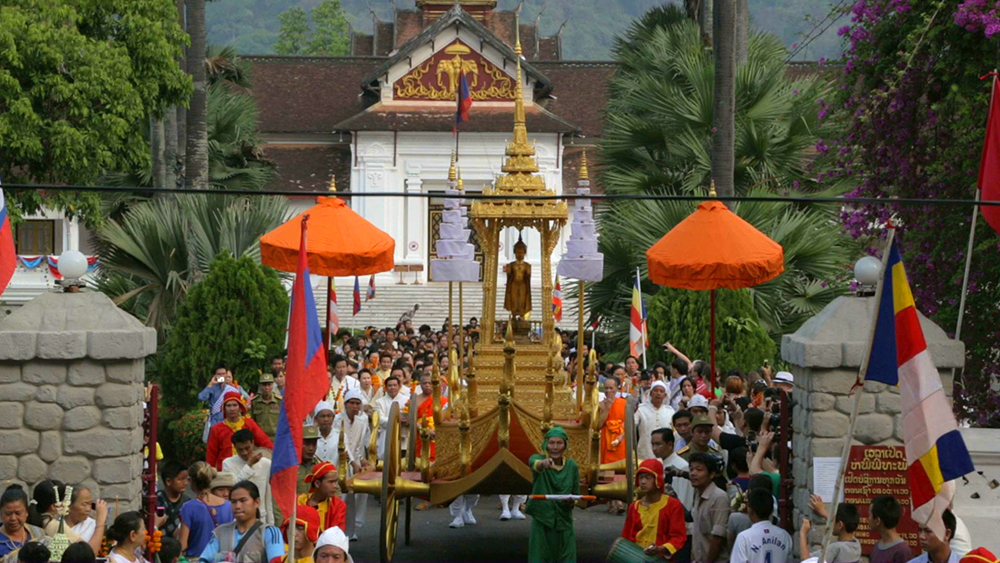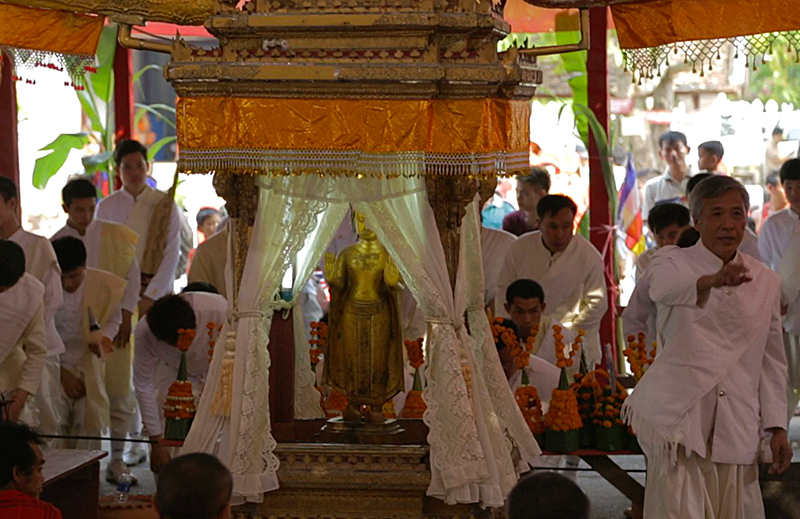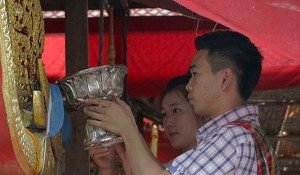It’s difficult to express the significance to the people of Luang Prabang and Laos of the Pra Bang. For Luang Prabang, this small gilded statue, after which Luang Prabang is named, marks the beginning of written history, the formation of the Lan Xan Empire and the Lao identity and the coming of Theravada Buddhism as the state religion.
It’s a small statue of the Buddha (in the “calming family quarrels” pose) that’s believed to be the protector of Luang Prabang.
It arrived as a gift to the king of the new Lao empire from his father-in-law, the King of Angkor, around 1353. (Is it the real one or is the real one in Vientiane or Moscow? Is it pure gold or a bronze that’s been gilded? Does it matter?)
It’s had a difficult life. The temple it was in was burnt down (Wat Visoun), it was stolen by the Thais (twice) and the last thirty years or so have not been its happiest.
When the communists took over in 1975, they aimed to destroy the old feudal order. And the Pra Bang featured strongly in the melding of religion and rule. So, it and the ceremonies that went with it were not well liked by the new Government. But it has remained a constant in the long history of Luang Prabang which has seen wars with the Burmese, Thais, Vietnamese and amongst themselves as well. It has survived wars, fires and theft to remains a powerful symbol of Luang Prabang and Laos.
It currently lives in a wing of the old palace, now the museum, where you are able to view it but not photograph it.
But, once a year, during Pi Mai (Lao New Year around April), it comes out to be carried down to Wat Mai where people are able to venerate it and pray to it for a day or so. It’s quite a big deal.
A large, ornately carved, gilded wagon is parked in front of the palace. Prayers are said both inside and outside the building. The little statue is carried by attendants wearing white gloves down the stairs of the palace and up into a palanquin atop the golden wagon. Despite its small size, it’s obviously very heavy and the guys who carry it clearly show the strain.
Once standing in its place atop the wagon, a priest carries out a ceremony to bless and cleans the statue. His little pointed hat is put in place and with the orchestra playing and conch shells blown it starts its creaking journey out of the palace and down the road to Wat Mai.
It’s quite a procession with orange clad monks, silk and satin clothed officials and VIP’s carrying their best silver bowls, a band of young men in white jackets sounding conch shells and then the Pra Bang, high above the heads of the crowd.
The wagon is pushed and steered from behind and out the front walks one old man carrying a baton as the crowd joins in behind singing and sounding gongs.
It’s only a short distance to Wat Mai where the attendants take him down from the wagon and carry him to his new position under a large temporary roof structure erected in the forecourt of Wat Mai.
Here, he is placed in another mini temple surrounded by flowers and covered by an ornate gilded roof.
On either side of the enclosure are wide timber stairs leading up and down (there are helpful signs to tell which is which). From the top of the stairs spanning the short distance to the roof of the Pra Bang’s mini temple are things called “hanglins”. These are in the shape of nagas (mythical snake-like creatures) with their rear end at the top of the stairs and their heads over the roofed structure under which the Pra Bang stands.
Devotees climb the stairs carrying large silver bowls filled with scented water. They say a prayer and empty the contents of their bowl into the back of the hanglin. The water runs down a channel inside the naga, falls through an opening in the roof and showers down over the Pra Bang. This aspersion brings a blessing to the person carrying out the ritual. As the water hits the floor of the Pra Bang’s structure, it is channeled away and collected to be used on Buddha statues in people’s homes.
Despite the religious significance of this ceremony, I found myself very welcome – in fact, when attendants saw that I was trying to photograph the statue while respectively staying at a distance, I was ushered down to the front (mind you kneeling on the thin mat on top of rough concrete was a bit painful – but, you know – must suffer for art!).
The two spirits of Luang Prabang, Pu Nyer and Nya Nyer, bring water collected from the Nam Khan river at the home of a naga called Kham La and pour this over the Pra Bang in a marriage between the old animist religion and Buddhism.
The Pra Bang is left there for a full day and then the whole thing is done in reverse to bring the Pra Bang back to its place in the palace.
Here in Luang Prabang, this ceremony and many others are still carried out much as they were hundreds of years ago. But here, the scale is small and the people accommodating. As an outsider, you are welcomed into the mix and can get close enough to really feel a part of the ritual – at least for an hour or so.



